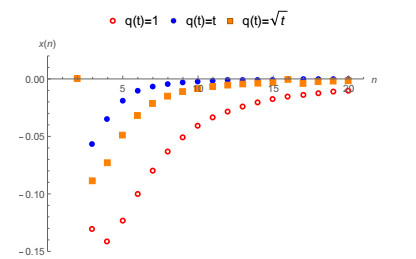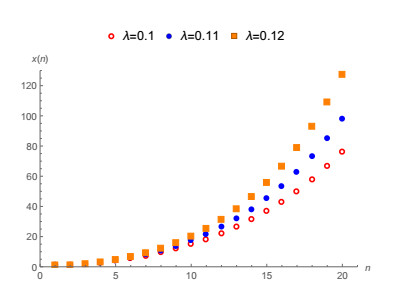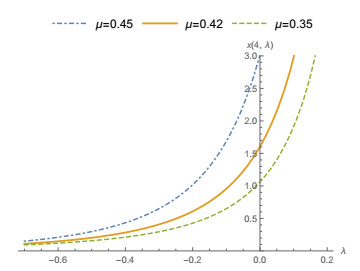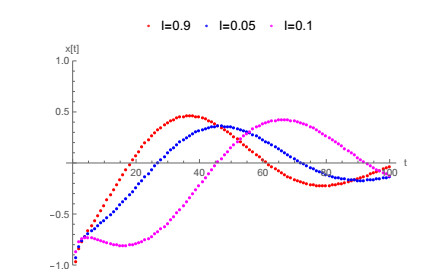1.
Introduction
Fractional calculus is a popular subject because of having a lot of application areas of theoretical and applied sciences, like engineering, physics, biology, etc. Discrete fractional calculus is more recent area than fractional calculus and it was first defined by Diaz–Osler [1], Miller–Ross [2] and Gray–Zhang [3]. More recently, the theory of discrete fractional calculus have begun to develop rapidly with Goodrich–Peterson [4], Baleanu et al. [5,6], Ahrendt et al. [7], Atici–Eloe [8,9], Anastassiou [10], Abdeljawad et al. [11,12,13,14,15,16], Hein et al. [17] and Cheng et al. [18], Mozyrska [19] and so forth [20,21,22,23,24,25].
Fractional Sturm–Liouville differential operators have been studied by Bas et al. [26,27], Klimek et al.[28], Dehghan et al. [29]. Besides that, Sturm–Liouville differential and difference operators were studied by [30,31,32,33]. In this study, we define DFHA operators and prove the self–adjointness of DFHA operator, some spectral properties of the operator.
More recently, Almeida et al. [34] have studied discrete and continuous fractional Sturm–Liouville operators, Bas–Ozarslan [35] have shown the self–adjointness of discrete fractional Sturm–Liouville operators and proved some spectral properties of the problem.
Sturm–Liouville equation having hydrogen atom potential is defined as follows
In quantum mechanics, the study of the energy levels of the hydrogen atom leads to this equation. Where R is the distance from the mass center to the origin, ℓ is a positive integer, a is real number E is energy constant and r is the distance between the nucleus and the electron.
The hydrogen atom is a two–particle system and it composes of an electron and a proton. Interior motion of two particles around the center of mass corresponds to the movement of a single particle by a reduced mass. The distance between the proton and the electron is identified r and r is given by the orientation of the vector pointing from the proton to the electron. Hydrogen atom equation is defined as Schrödinger equation in spherical coordinates and in consequence of some transformations, this equation is defined as
Spectral theory of hydrogen atom equation is studied by [39,40,41]. Besides that, we can observe that hydrogen atom differential equation has series solution as follows ([39], p.268)
Recently, Bohner and Cuchta [36,37] studied some special integer order discrete functions, like Laguerre, Hermite, Bessel and especially Cuchta mentioned the difficulty in obtaining series solution of discrete special functions in his dissertation ([38], p.100). In this regard, finding series solution of DFHA equations is an open problem and has some difficulties in the current situation. For this reason, we study to obtain solutions of DFHA eq.s in a different way with representation of solutions.
In this study, we investigate DFHA equation in Riemann–Liouville and Grü nwald–Letnikov sense. The aim of this study is to contribute to the spectral theory of DFHA operator and behaviors of eigenfunctions and also to obtain the solution of DFHA equation.
We investigate DFHA equation in three different ways;
i) (nabla left and right) Riemann–Liouville (R–L)sense,
ii) (delta left and right) Grünwald–Letnikov (G–L) sense,
iii) (nabla left) Riemann–Liouville (R–L)sense,
2.
Preliminaries
Definition 2.1. [42] Falling and rising factorial functions are defined as follows respectively
where Γ is the gamma function, α∈R.
Remark 2.1. Delta and nabla operators hold the following properties
Definition 2.2. [2,8,11] Nabla fractional sum operators are given as below,
(i) The left fractional sum of order μ>0 is defined by
(ii) The right fractional sum of order μ>0 is defined by
where ρ(t)=t−1 is called backward jump operators, Na={a,a+1,...}, bN={b,b−1,...}.
Definition 2.3. [12,14] Nabla fractional difference operators are as follows,
(i) The left fractional difference of order μ>0 is defined by
(ii) The right fractional difference of order μ>0 is defined by
Fractional differences in (2.6−2.7) are called the Riemann–Liouville (R–L) definition of the μ-th order nabla fractional difference.
Definition 2.4. [1,18] Fractional difference operators are given as follows
(i) The delta left fractional difference of order μ, 0<μ≤1, is defined by
(ii) The delta right fractional difference of order μ, 0<μ≤1, is defined by
fractional differences in (2.8−2.9) are called the Grünwald–Letnikov (G–L) definition of the μ-th order delta fractional difference.
Definition 2.5 [14] Integration by parts formula for R–L nabla fractional difference operator is defined by, u is defined on bN and v is defined on Na,
Definition 2.6. [34] Integration by parts formula for G–L delta fractional difference operator is defined by, u, v is defined on {0,1,...,n}, then
Definition 2.7. [17] f:Na→R, s∈ℜ, Laplace transform is defined as follows,
where ℜ=C∖{1} and ℜ is called the set of regressive (complex) functions.
Definition 2.8. [17] Let f,g:Na→R, all t∈Na+1, convolution of f and g is defined as follows
where ρ(s) is the backward jump function defined in [42] as
Theorem 2.1. [17] f,g:Na→R, convolution theorem is expressed as follows,
Lemma 2.1. [17] f:Na→R, the following property is valid,
Theorem 2.2. [17] f:Na→R, 0<μ<1, Laplace transform of nabla fractional difference
Definition 2.9. [17] For |p|<1, α>0, β∈R and t∈Na, Mittag–Leffler function is defined by
Theorem 2.3. [17] For |p|<1, α>0, β∈R, |1−s|<1 and |s|α>p, Laplace transform of Mittag–Leffler function is as follows,
3.
Main results
3.1. Discrete fractional hydrogen–atom equations
Let us consider equations in three different forms;
i) L1 DFHA operator L1 is defined in (nabla left and right) R–L sense,
where l is a positive integer or zero, q(t)+2t−l(l+1)t2 are named potential function., λ is the spectral parameter, t∈[a+1,b−1], x(t)∈l2[a+1,b−1], a>0.
ii) L2 DFHA operator L2 is defined in (delta left and right) G–L sense,
where p,q,l,λ is as defined above, t∈[1,n], x(t)∈l2[0,n].
iii) L3 DFHA operator L3 is defined in (nabla left) R–L sense,
p,q,l,λ is as defined above, t∈[a+1,b−1], a>0.
Theorem 3.1. DFHA operator L1 is self–adjoint.
Proof.
Subtracting (16−17) from each other
and applying definite sum operator to both side of the last equality, we have
Applying the integration by parts formula (2.10) to right hand side of (18), we have
The proof completes.
Theorem 3.2. Eigenfunctions, corresponding to distinct eigenvalues, of the equation (3.2) are orthogonal.
Proof. Assume that λα and λβ are two different eigenvalues corresponds to eigenfunctions u(n) and v(n) respectively for the equation (3.1),
Multiplying last two equations to v(n) and u(n) respectively, subtracting from each other and applying sum operator, since the self–adjointness of the operator L1, we get
since λα≠λβ,
and the proof completes.
Theorem 3.3. All eigenvalues of the equation (3.1) are real.
Proof. Assume λ=α+iβ, since the self–adjointness of the operator L1, we have
Since ⟨u,u⟩r≠0,
and hence β=0. So, the proof is completed.
Self–adjointness of L2 DFHA operator G–L sense, reality of eigenvalues and orthogonality of eigenfunctions of the equation 3.2 can be proven in a similar way to the Theorem 3.1–3.2–3.3 by means of Definition 2.5.
3.2. Representation of solution for discrete fractional hydrogen atom equation
Theorem 3.4.
where p(t)>0, r(t)>0, q(t) is defined and real valued, λ is the spectral parameter. The sum representation of solution of the problem (3.7)−(3.8) is given as follows,
Proof. Taking Laplace transform of the equation (3.7) by Theorem 2.2 and take (l(l+1)t2−2t+q(t))x(t)=g(t),
Using Lemma 2.1, we have
Now, taking inverse Laplace transform of the equation (3.10) and applying convolution theorem, then we have the representation of solution of the problem (3.7)−(3.8),
|λ|<1, |1−s|<1 and |s|α>λ from Theorem 2.3., i.e.
Consequently, we have sum representation of solution for DFHA problem 3.7–3.8
3.3. Applications and visual results
Presume that c1=1,c2=0,a=0 in the representation of solution (3.9) and hence we may observe the behaviors of solutions in following figures (Figures 1–7) and tables (Tables 1–3);
4.
Conclusion
We have analyzed DFHA equation in Riemann–Liouville and Grü nwald–Letnikov sense. Self–adjointness of the DFHA operator is presented and also, we have proved some significant spectral properties for instance, orthogonality of distinct eigenfunctions, reality of eigenvalues. Moreover, we give sum representation of the solutions for DFHA problem and find the solutions of the problem. We have carried out simulation analysis with graphics and tables. The aim of this paper is to contribute to the theory of hydrogen atom fractional difference operator.
We observe the behaviors of solutions by changing the order of the derivative μ in Figure 1 and Figure 5, by changing the potential function q(t) in Figure 2, we compare solutions under different λ eigenvalues in Figure 3, and Figure 7, also we observe the solutions by changing μ with a specific eigenvalue in Figure 4 and by changing l values in Figure 6.
We have shown the solutions by changing the order of the derivative μ in Table 1, by changing the potential function q(t) and λ eigenvalues in Table 2, Table 3.
Acknowledgment
The authors would like to thank the editor and anonymous reviewers for their careful reading of our manuscript and their many insightful comments and suggestions.
Conflict of interest
The authors declare no conflict of interest.
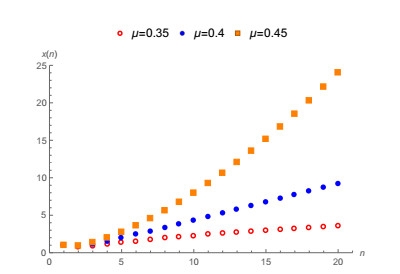









 DownLoad:
DownLoad:
